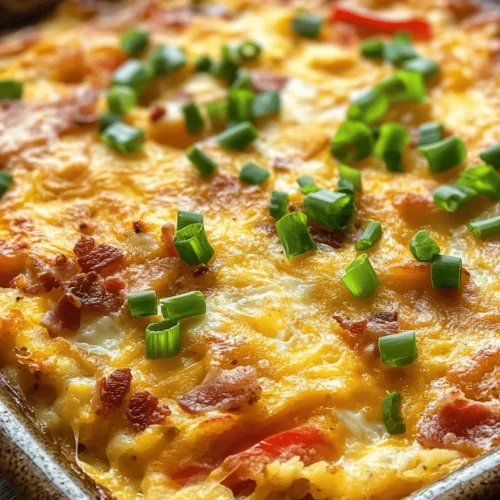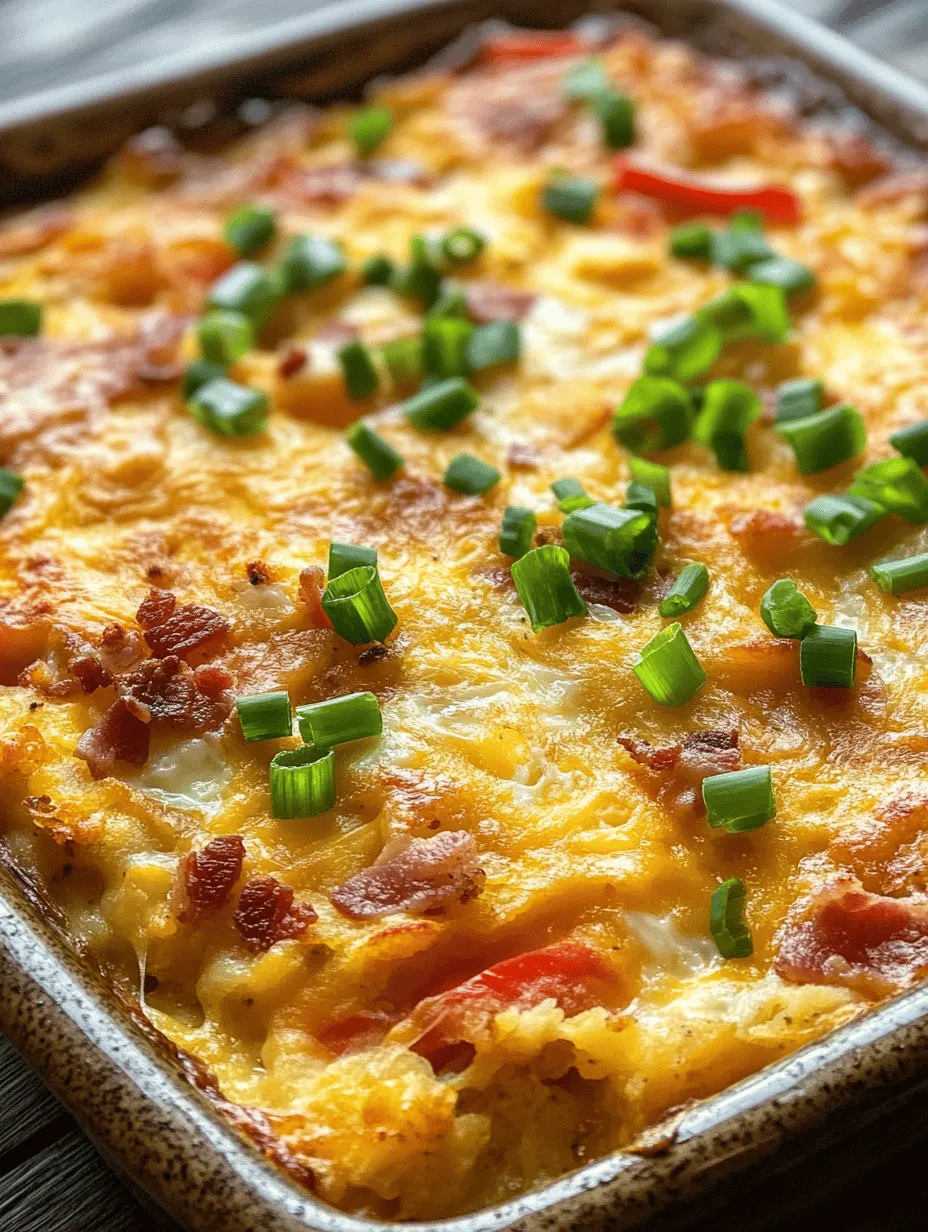Introduction
In the realm of breakfast dishes, few can rival the comforting embrace of a hashbrown breakfast casserole. This delectable recipe combines the hearty flavors of crispy hashbrowns, savory meats, and creamy cheese, making it a beloved choice for family gatherings, brunches, or simply a cozy morning at home. The beauty of a hashbrown breakfast casserole lies not only in its taste but also in its versatility and ease of preparation. Whether you are feeding a crowd or just looking to whip up a satisfying meal, this dish is sure to please.
The origins of breakfast casseroles can be traced back to the mid-20th century, a time when convenience and hearty meals became staples in American households. This trend allowed home cooks to combine various ingredients into one easy-to-prepare dish, saving time and effort in the kitchen. Today, breakfast casseroles have evolved into countless variations, but the hashbrown breakfast casserole remains a favorite due to its unique blend of textures and flavors.
In this article, we will delve deeper into the origins of breakfast casseroles, highlight the versatility of hashbrowns, and provide you with a step-by-step guide to creating the ultimate hashbrown breakfast casserole that not only satisfies the palate but also warms the soul.
The Allure of Breakfast Casseroles
Understanding the Popularity and Comfort of Breakfast Casseroles
Breakfast casseroles have earned their place in the hearts (and stomachs) of many for their comforting nature and ease of preparation. They encapsulate the essence of a hearty breakfast in a single dish, allowing for a medley of flavors and textures that can cater to a wide range of tastes. The communal aspect of sharing a casserole during family brunches or holiday gatherings adds to their charm, making them a go-to option for bringing people together.
Moreover, breakfast casseroles are incredibly adaptable. They can be made ahead of time and stored in the refrigerator or freezer, making them perfect for busy mornings or as a make-ahead meal for guests. The ability to customize the ingredients based on personal preferences or dietary restrictions further enhances their appeal. From vegetarian to meat-lovers options, breakfast casseroles offer something for everyone.
Exploring the History and Evolution of Breakfast Casseroles
The concept of a casserole can be traced back to the 18th century when the French invented the dish as a way of combining various ingredients baked together. However, the breakfast casserole as we know it today gained popularity in the United States post-World War II. During this period, convenience foods and frozen ingredients became widely available, paving the way for the modern casserole.
In the 1960s and 70s, the rise of the frozen food industry introduced hashbrowns and other pre-prepared ingredients, making it easy for home cooks to create satisfying breakfast dishes without spending hours in the kitchen. The hashbrown breakfast casserole emerged as families sought hearty yet simple meals that could be prepared in advance. Today, it continues to be a staple in many households, often passed down through generations as a cherished family recipe.
Why Hashbrowns Are the Star Ingredient in Many Breakfast Dishes
Hashbrowns have become synonymous with breakfast for good reason. Their crispy exterior and tender interior create a delightful contrast that perfectly complements other breakfast staples. They provide a satisfying base for a variety of toppings, making them an ideal canvas for both savory and sweet flavors.
Moreover, hashbrowns are incredibly versatile. They can be seasoned in countless ways, paired with diverse ingredients, and cooked to various textures. This adaptability allows hashbrowns to shine in a multitude of dishes, from classic breakfast platters to innovative casseroles. Their ability to absorb flavors from other ingredients enhances the overall taste experience, making them an essential component of the ultimate breakfast casserole.
Ingredients Overview
To create a mouthwatering hashbrown breakfast casserole, it’s essential to understand the role each ingredient plays in building flavor and texture. Let’s take an in-depth look at the key components of this delicious dish.
Frozen Hashbrowns: Convenience and Flavor
Frozen hashbrowns are the star of the show, providing a crispy foundation for the casserole without the need for peeling or grating fresh potatoes. They offer the convenience of being readily available and save significant prep time. When using frozen hashbrowns, it’s crucial to allow them to thaw and drain any excess moisture to avoid a soggy casserole.
Cheddar Cheese: A Classic Choice for Richness
Cheddar cheese is a classic addition to hashbrown casseroles, known for its rich flavor and excellent melting properties. Its sharpness enhances the savory elements of the dish, creating a comforting and indulgent experience. Feel free to experiment with different cheese varieties, such as Monterey Jack or pepper jack, to add unique flavors and a bit of spice.
Meats: Bacon vs. Sausage – Which to Choose?
The choice of meat can significantly alter the flavor profile of your casserole. Bacon and sausage are both popular options, with bacon providing a smoky, crispy texture and sausage offering a savory, juicy bite. You can choose one or blend both for a delightful combination. If you prefer a vegetarian option, consider substituting with plant-based sausage or incorporating vegetables for added nutrition.
Veggies: Enhancing Flavor with Onions and Bell Peppers
Adding vegetables like onions and bell peppers not only enhances the flavor of the casserole but also adds color and nutrition. Diced onions bring a sweet and savory note, while bell peppers provide a slight crunch and a burst of freshness. Feel free to add other vegetables such as spinach, mushrooms, or tomatoes to tailor the casserole to your liking.
The Importance of Eggs and Milk in Binding the Casserole
Eggs and milk serve as the binding agents in a breakfast casserole, ensuring that all the ingredients meld together beautifully during baking. Eggs add richness and protein, while milk contributes moisture, preventing the casserole from becoming dry. The combination creates a creamy texture that holds the dish together, making each bite a delightful experience.
Preparation Steps
Creating the ultimate hashbrown breakfast casserole is a straightforward process that yields delicious results. Before diving into the assembly, let’s ensure you have the right kitchen tools and equipment ready.
Prepping for Success: Essential Kitchen Tools and Equipment
To prepare your hashbrown breakfast casserole, gather the following kitchen essentials:
– Large Mixing Bowl: For combining all the ingredients.
– 9×13-inch Baking Dish: The perfect size for baking the casserole and ensuring even cooking.
– Whisk: For beating the eggs and mixing the milk.
– Spatula: For folding ingredients together gently.
– Knife and Cutting Board: For chopping vegetables and meats.
– Aluminum Foil: To cover the casserole while baking to prevent over-browning.
Step-by-Step Instructions for Assembling the Casserole
1. Preheat the Oven: Start by preheating your oven to 350°F (175°C). This ensures that the casserole bakes evenly and thoroughly.
2. Prepare the Hashbrowns: If using frozen hashbrowns, allow them to thaw and drain any excess moisture. Spread the hashbrowns evenly in the bottom of your greased baking dish, creating a solid base.
3. Cook the Meats: In a skillet over medium heat, cook your choice of bacon or sausage until browned and fully cooked. If using bacon, chop it into bite-sized pieces. Once cooked, drain any excess fat and set aside to cool slightly.
4. Sauté the Vegetables: In the same skillet, add diced onions and bell peppers (and any other vegetables you prefer) and sauté until softened, about 3-5 minutes. This step enhances their flavors and ensures they are tender in the casserole.
5. Mix the Egg Mixture: In a large mixing bowl, whisk together the eggs and milk until well combined. Season with salt, pepper, and any other herbs or spices you enjoy, such as garlic powder or paprika.
6. Combine Ingredients: In the mixing bowl, fold in the cooked meats, sautéed vegetables, and shredded cheddar cheese into the egg mixture. Ensure everything is evenly coated and mixed well.
7. Assemble the Casserole: Pour the egg and ingredient mixture over the hashbrown layer in the baking dish, spreading it evenly to cover the hashbrowns completely.
8. Bake: Cover the baking dish with aluminum foil and place it in the preheated oven. Bake for 30 minutes, then remove the foil and bake for an additional 15-20 minutes, or until the casserole is set and the top is golden brown.
9. Cool and Serve: Allow the casserole to cool for a few minutes before slicing into squares and serving. This will help the casserole hold its shape and make it easier to serve.
Tips for Ensuring Even Cooking and Perfect Texture
– Thaw Hashbrowns Completely: Ensure that your frozen hashbrowns are fully thawed to avoid excess moisture in the casserole.
– Avoid Overcrowding: If adding a variety of vegetables or meats, be mindful not to overcrowd the casserole, as this can lead to uneven cooking.
– Check for Doneness: Use a toothpick or knife inserted into the center of the casserole; it should come out clean when the casserole is fully cooked.
– Let it Rest: Allow the casserole to rest for about 10 minutes after baking. This helps it firm up, making it easier to cut into squares.
With these preparation steps, you’re well on your way to creating a hashbrown breakfast casserole that will delight your family and friends. In the next section, we will explore additional tips and tricks to elevate your casserole experience, ensuring you serve the best version of this beloved dish. Stay tuned for more delicious insights and variations to make your breakfast casserole truly memorable.

Baking the Casserole
Baking a hashbrown breakfast casserole is where the magic truly happens. The right temperature and timing are crucial to achieving a perfectly cooked dish that is both flavorful and visually appealing.
Understanding the Baking Process: Temperature and Time Explained
To start, preheat your oven to 375°F (190°C). This moderate temperature allows the casserole to bake evenly, ensuring that the hashbrowns become crispy, the eggs set perfectly, and the cheese melts beautifully. Generally, your casserole will need to bake for approximately 45 to 55 minutes. However, cooking time can vary based on your oven and the size of your baking dish, so it’s essential to keep an eye on it.
What to Look for to Know When the Casserole is Done
As the casserole bakes, the aroma will fill your kitchen, signaling that breakfast is nearly ready. To determine if your hashbrown breakfast casserole is done, look for a few telltale signs:
1. Firmness: Gently shake the baking dish. The casserole should jiggle slightly in the center but not be liquid. If it still appears runny, give it a bit more time.
2. Color: The top should be a beautiful golden brown, which indicates that the cheese is perfectly melted and slightly crisped.
3. Temperature: If you have a food thermometer, the internal temperature of the casserole should reach 160°F (71°C) to ensure that the eggs are fully cooked.
How to Achieve That Perfect Golden-Brown Top
Achieving that coveted golden-brown top is simple with a few techniques:
– Cover Initially: You may choose to cover the casserole with aluminum foil for the first 30 minutes of baking. This helps to set the eggs without over-browning the cheese. After 30 minutes, remove the foil to allow the top to crisp up.
– Broil for Extra Crispness: If you want an extra crispy top, turn on the broiler for the last 3 to 5 minutes of baking. Watch it closely, as it can go from perfectly browned to burnt in no time.
Serving Suggestions
Once your casserole is out of the oven and has cooled for a few minutes, it’s time to think about how to serve it up.
Creative Ways to Serve Your Hashbrown Breakfast Casserole
This breakfast casserole is not only delicious but also visually appealing. Cut it into squares or wedges and serve it directly from the baking dish. You could also use a large spatula for a more refined presentation on individual plates. For a buffet-style breakfast, let your guests serve themselves from the dish.
Pairing Ideas: What to Serve Alongside Your Casserole
While the casserole is filling on its own, consider adding some complementary sides to create a well-rounded breakfast experience:
– Fresh Fruits: A bowl of mixed berries or sliced melons brings a refreshing contrast to the savory casserole.
– Salads: A light green salad with a tangy vinaigrette can brighten up the meal.
– Breakfast Meats: Crispy bacon or breakfast sausage links are classic additions that pair wonderfully with the rich flavors of the casserole.
Garnishes and Toppings: Elevating Your Dish with Green Onions
To elevate your dish, consider garnishing your hashbrown breakfast casserole with finely chopped green onions or chives just before serving. This not only adds a pop of color but also a fresh, mild onion flavor that complements the creamy and cheesy elements of the casserole.
Nutritional Insights
Understanding the nutritional profile of your hashbrown breakfast casserole is essential, especially if you’re looking to strike a balance between indulgent comfort food and healthier choices.
A Closer Look at the Nutritional Profile of the Casserole
The nutritional content of your casserole will depend on the ingredients you choose. Here’s a general breakdown of what you can expect per serving (considering a standard recipe with eggs, hashbrowns, cheese, and some vegetables):
– Calories: Approximately 300-400 calories
– Protein: 15-20 grams
– Carbohydrates: 30-35 grams
– Fats: 15-20 grams
These numbers can vary significantly based on the type of cheese used, the addition of meats, and the amount of oil or butter incorporated.
Balancing Indulgence with Nutrition: Making Healthier Choices
To enhance the nutritional value of your casserole, consider the following adjustments:
– Whole Grain Hashbrowns: If available, opt for whole grain or sweet potato hashbrowns for added fiber and nutrients.
– Reduced-Fat Cheese: Use reduced-fat cheese or a combination of cheeses to lower the overall fat content while still enjoying that creamy texture.
– Vegetable Additions: Increase the vegetable content by incorporating spinach, bell peppers, or mushrooms. This not only boosts the nutritional profile but also adds flavor and texture.
Portion Control and Serving Sizes for Family Meals
Portion control is essential, especially for larger gatherings. A typical serving size for this casserole is about 1/6th of the dish. When serving, consider using a measuring cup or a standard kitchen scoop to ensure everyone receives a similar portion, helping to manage calorie intake while allowing guests to enjoy this hearty breakfast.
Adapting the Recipe
One of the greatest aspects of the hashbrown breakfast casserole is its versatility. You can easily adapt the recipe to cater to various dietary needs and preferences.
Customizing Your Casserole: Vegetarian and Gluten-Free Options
For a vegetarian version, simply omit any meat and increase the amount of vegetables used. You can also add in plant-based sausage alternatives for added flavor and protein.
If you need a gluten-free option, ensure that your hashbrowns and any other ingredients are certified gluten-free. Many brands offer gluten-free bread or substitutes that can be incorporated into the dish without sacrificing flavor.
Substitutions for Different Dietary Needs
Here are some quick substitutions to consider:
– Eggs: For a vegan version, use a chickpea flour mixture or commercial egg replacer.
– Dairy: Substitute dairy products with plant-based alternatives, such as almond milk or coconut yogurt.
– Hashbrowns: Use riced cauliflower as a low-carb alternative to traditional hashbrowns.
Exploring Flavor Variations: Adding Spices and Herbs
Don’t hesitate to experiment with spices and herbs to customize the flavor profile of your casserole. Here are a few ideas:
– Herbs: Fresh herbs like thyme, rosemary, or parsley can enhance the flavor significantly.
– Spices: Consider adding smoked paprika, garlic powder, or a pinch of cayenne pepper for a bit of heat.
– Cheese Variations: Mix it up with different types of cheese like pepper jack for a spicy kick or feta for a Mediterranean twist.
Conclusion
The hashbrown breakfast casserole is more than just a meal; it’s a symbol of comfort and togetherness. With its easy preparation and hearty ingredients, it can be tailored to suit any occasion or dietary preference. This dish not only fills the stomach but also warms the heart, making it a staple in many households. Whether enjoyed on a lazy Sunday morning or served at a festive gathering, the ultimate hashbrown breakfast casserole is sure to delight everyone at the table. Embrace the joy of cooking and savor the deliciousness that this recipe brings to your breakfast table.


